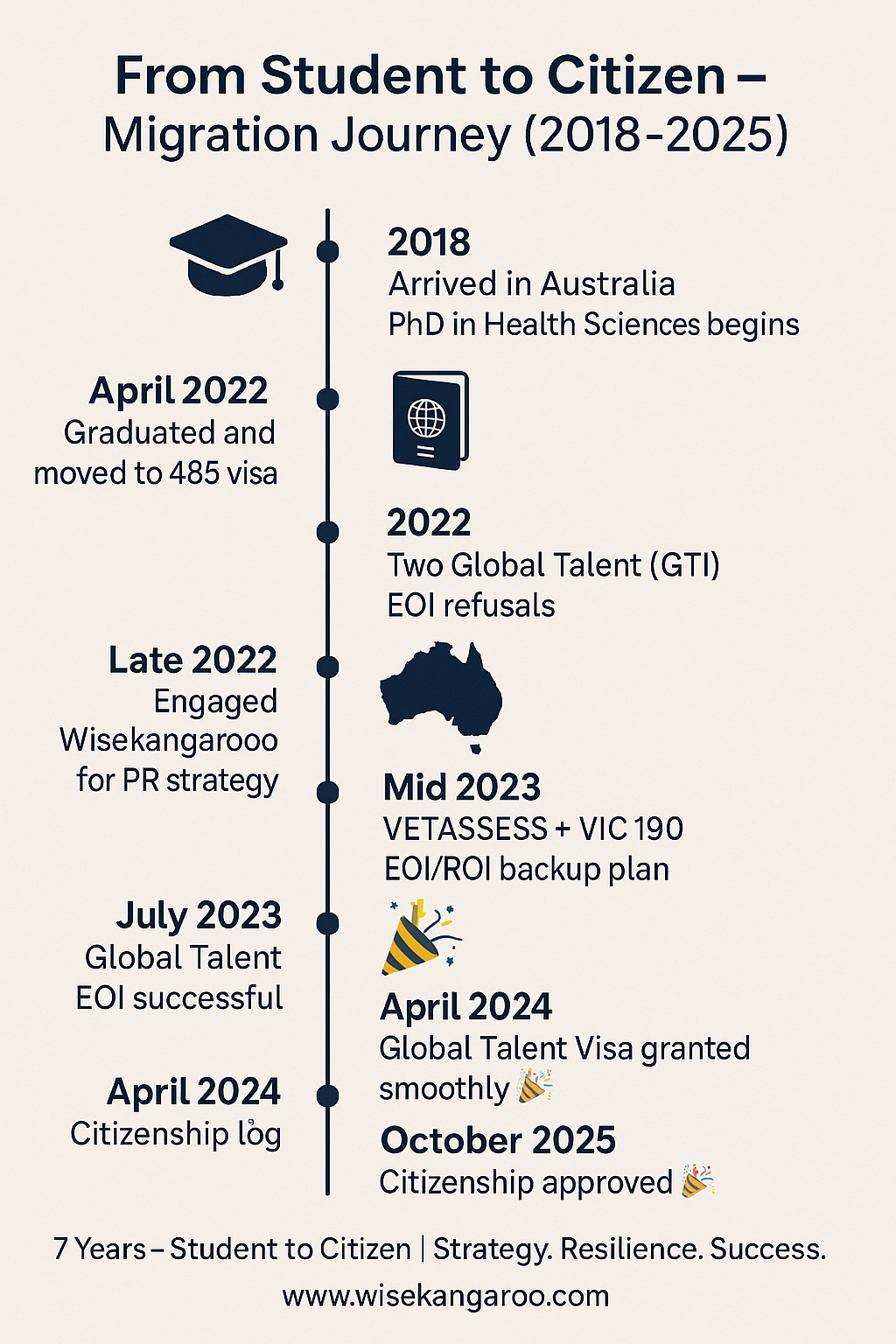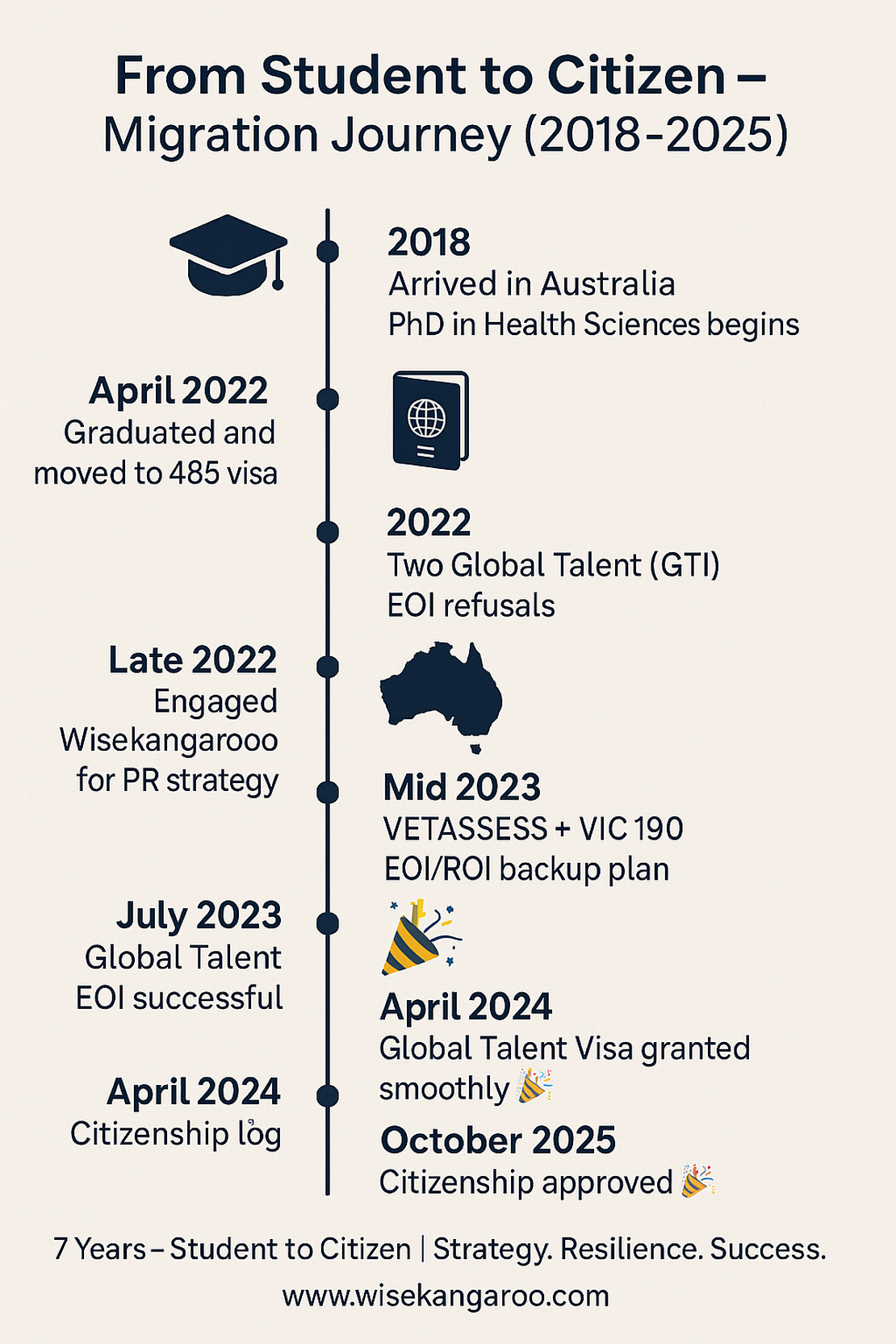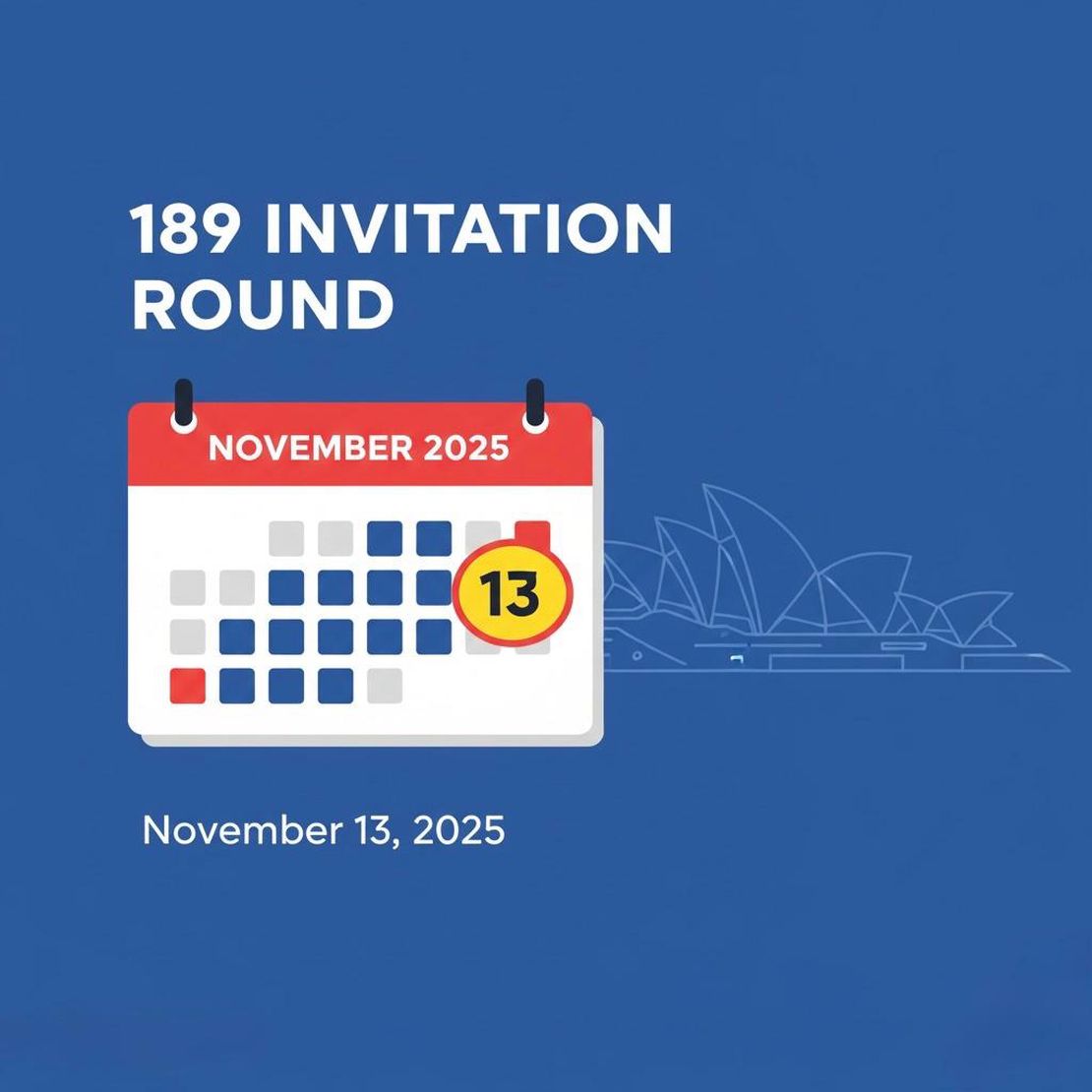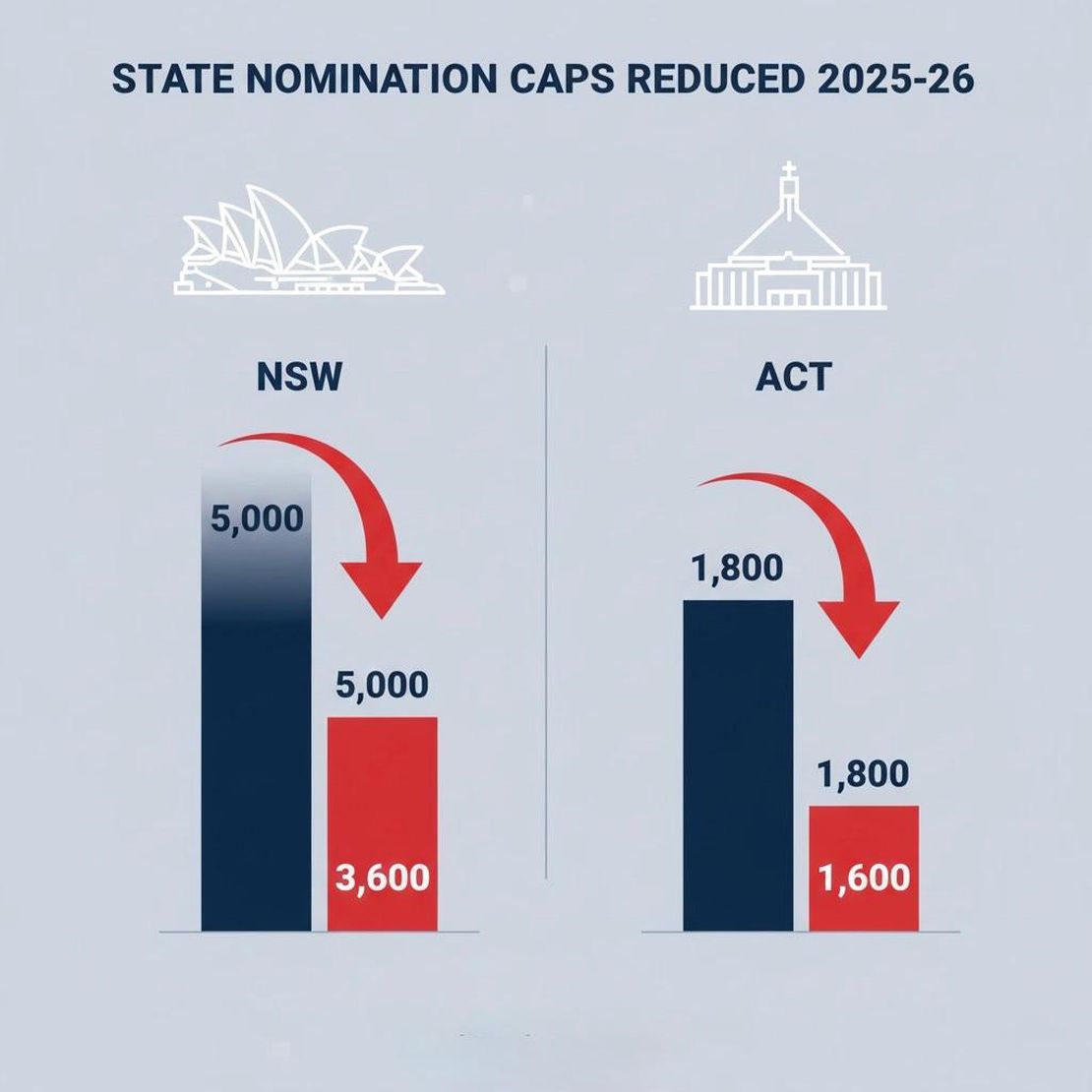Every migration story has a heartbeat — moments of struggle, growth, and triumph. But some stories capture the essence of why so many bright minds choose Australia: not just for study, but for a new life built on hard work, resilience, and hope.
This is one of those stories.
It’s about our client, a public health researcher, who came to Australia with a dream — to pursue a PhD, contribute to the nation’s health sector, and build a future here. Seven years later, after navigating COVID-19 lockdowns, uncertain pathways and long processing wait times, he now proudly holds Australian citizenship.
His journey from international student to permanent resident to citizen demonstrates what’s possible when determination meets strategic planning.
The Beginning: A New Life, A World in Lockdown
In 2018, he arrived in Australia to begin his PhD in Health Sciences at a leading Australian university. With over ten years of experience in public health research already under his belt, he was well-established in his field and recognized for his contributions to health policy and epidemiology.
Like many international students, he saw Australia not only as a place to advance his academic credentials, but as a land of opportunity, stability, and world-class research infrastructure — a place where his family could build a lasting future.
Then came COVID-19.
The global pandemic hit during his final research years. Borders closed. Travel became impossible. He found himself unable to return home for years, separated from immediate family and friends during one of the most isolating periods in modern history.
Yet through the uncertainty, he persevered. He continued his research, adapted to remote work and virtual collaborations, and completed his PhD on schedule in 2022 — a testament to the resilience that would later define his entire migration journey.
After Graduation: The Search for a Permanent Pathway
After completing his doctorate, he transitioned to the Temporary Graduate visa (subclass 485) — the natural next step for international graduates hoping to remain in Australia while exploring permanent residency pathways.
But as many skilled migrants discover, finding a clear route to permanent residency isn’t always straightforward, especially in competitive fields like health research where employer sponsorship opportunities can be limited.
Add to the fact that the points based visas penalise those who are over 40.
Two GTI Applications, Two Refusals
Confident in his academic credentials — a PhD from an Australian institution, high-impact research publications, and over a decade of public health experience — he decided to apply for the Global Talent Independent (GTI) visa on his own.
The Global Talent program (now replaced by the National Innovation Visa) was designed for exactly this profile: exceptional researchers and innovators in priority sectors like Health Industries.
Unfortunately, both applications were refused.
It wasn’t that he lacked the credentials. The issue was presentation, narrative, and strategic positioning — the difference between a collection of achievements and a compelling case that aligned with Australia’s national priorities.
Discouraged but not defeated, he reached out to us — not looking for shortcuts, but for strategic guidance to turn his qualifications into a successful outcome.
Rebuilding the Case: From Credentials to Strategic Narrative
When we first met with him, it was immediately clear he had the substance for a successful application: high-impact research, peer-reviewed publications, practical experience contributing to health policy, and ongoing contributions to Australia’s public health landscape.
But substance alone doesn’t guarantee success. The Global Talent visa (and its successor, the National Innovation Visa) requires more than credentials — it requires a narrative that connects your achievements to Australia’s innovation priorities and demonstrates exceptional global recognition.
Our Strategy
We started from scratch, rebuilding his case with three core elements:
1. Reframing Achievements Through Australian Benefit
Rather than presenting his work as purely academic milestones, we repositioned his research contributions as direct benefits to Australia’s Health Industries sector — one of the nation’s highest-priority areas for innovation talent.
We highlighted:
- His contributions to public health policy frameworks
- Research addressing Australia’s healthcare challenges
- Collaboration with Australian institutions and researchers
- Potential for ongoing impact in Australia’s health innovation ecosystem
2. Demonstrating Global Recognition
We compiled comprehensive evidence of his standing in the field:
- Citations and impact metrics from his research publications
- Professional memberships in internationally recognized health organizations
- Evidence of peer recognition through research collaboration requests
- Conference presentations and thought leadership contributions
By late 2022, his new Global Talent Expression of Interest (EOI) was ready — stronger, sharper, and strategically positioned for success.
The Backup Plan: Protecting Against Age and Processing Delays
While we were confident in the rebuilt GTI application, we couldn’t ignore a critical factor: time.
He was approaching 45 years old — a significant threshold in skilled migration. Under Australia’s points-based system, skilled migration programs have an upper age criteria of 45, effectively closing many pathways.
With Department of Home Affairs processing times stretching months (and sometimes years), we couldn’t afford to rely on a single pathway, no matter how strong.
Strategic Layering: The 190 Backup
We developed a comprehensive backup strategy:
1. Skills Assessment Renewal
We renewed his VETASSESS skills assessment for his public health occupation, ensuring he remained eligible for points-based skilled migration pathways.
2. State Nomination Preparation
We prepared a Subclass 190 State Nominated visa application for Victoria — a state with strong health research sectors and consistent demand for public health professionals.
This meant that even if the GTI application faced unexpected delays or policy changes, he had a viable alternative pathway to permanent residency before the age cutoff.
This kind of strategic layering is what separates successful migration planning from hopeful waiting. In an uncertain policy environment, having parallel pathways provides insurance against the unexpected.
The Turning Point: Global Talent Visa Granted
In April 2024, after months of careful preparation, strategic positioning, and ongoing case management, his Global Talent Visa (subclass 858) was granted — a validation of both his professional excellence and the power of a well-structured, evidence-based application.
That grant transformed everything:
- Permanent residency from day one — no temporary visa limitations
- Freedom to work anywhere in Australia, including continuing his research
- Medicare coverage for his family
- Access to social services and support systems
- The ability to plan for the future without visa expiry dates hanging overhead
- A pathway to citizenship — just four years away
For someone who had spent years on temporary visas, navigating uncertainty and refusals, this moment represented more than a visa grant. It represented belonging.
The Final Chapter: Australian Citizenship
As he had already completed more than six years in Australia on temporary visas, he was eligible for Australian citizenship within 1 year of receiving his Permanent Residency. Exactly one year after receiving PR, in April 2025, we helped him lodge his citizenship by conferral application.
The process was straightforward. By October 2025, it was approved.
Seven years after arriving as an international student, he became an Australian citizen — the culmination of a journey that began with academic ambition and ended with a permanent home.
His story represents what thousands of international students dream of: to study, contribute, and ultimately call Australia home.
Lessons for International Students and Skilled Migrants
This success story isn’t just about one person’s journey — it’s a roadmap for others navigating the complex path from temporary to permanent residency to citizenship.
Key Takeaways
1. Refusals Aren’t the End — They’re Feedback
Both GTI EOI refusals weren’t about lacking merit. They reflected missing structure, inadequate presentation, and unclear alignment with program priorities. A refusal doesn’t mean you’re not qualified — it often means your case wasn’t positioned correctly.
2. Strategic Planning Beats Hope
Waiting and hoping for the best isn’t a strategy. Having a primary pathway (GTI) and a backup plan (190 state nomination) meant that regardless of processing times or policy changes, he had options. This is especially critical when age or other time-sensitive factors are involved.
3. Timing Matters — Act Early
Age cutoffs, policy changes, and processing delays can close pathways quickly. Starting the permanent residency process early — ideally while still on your student visa or 485 visa — gives you maximum flexibility and options.
4. Professional Guidance Makes a Difference
Self-lodging can work, but complex pathways like the National Innovation Visa program (previously called Global Talent) or strategic multi-pathway planning benefit enormously from expert guidance. The difference between a DIY application and a professionally managed one can be the difference between refusal and success.
5. Evidence Must Tell a Story
Your achievements matter, but they must be presented as a narrative that connects to Australia’s priorities. It’s not enough to be excellent — you must demonstrate how your excellence benefits Australia’s innovation, economic, or social goals.
6. Patience and Persistence Pay Off
From 2018 to 2025 — seven years of study, temporary visas, refusals, reapplications, and finally success. Migration journeys rarely follow a straight line. What matters is persistence, adaptability, and strategic planning.
The Pathway: Student Visa to Citizenship Timeline
Here’s how the journey unfolded:

This timeline shows that the path from student to citizen took seven years, but the strategic work that made it possible — rebuilding the GTI case, preparing backup pathways, and securing permanent residency — happened over an intensive 18-month period.
Is This Pathway Right for You?
If you’re an international student or recent graduate wondering whether this kind of success is possible for you, ask yourself these questions:
Are You a Strong Candidate for Innovation Pathways?
The National Innovation Visa (successor to the Global Talent program) is designed for exceptional achievers. You might be a candidate if:
- You have a PhD or equivalent research credentials in a priority sector
- Your work has measurable impact (publications, citations, patents, commercial outcomes)
- You can demonstrate global recognition in your field
- Your expertise aligns with one of Australia’s ten priority sectors (including Health Industries, Critical Technologies, Renewables, etc.)
If you’re earlier in your career, other pathways like Subclass 189 or Subclass 190 might be more appropriate.
Are You Planning Ahead?
Successful migration requires forward planning:
- Starting permanent residency planning while still on your student or 485 visa
- Understanding age cutoffs and points requirements
- Building your professional profile with an eye toward visa eligibility
- Seeking professional advice before attempting applications
Do You Have Backup Options?
Relying on a single pathway is risky. Strategic migration planning involves:
- Understanding multiple visa options you might qualify for
- Maintaining eligibility across different pathways
- Timing applications strategically
- Having contingency plans for processing delays or refusals
Why Work With Wisekangaroo
This case demonstrates what we do best at Wisekangaroo: transforming complex journeys into successful outcomes.
We don’t just process paperwork. We:
Honest Assessment
We’ll tell you honestly whether you’re ready for high-competition pathways like the National Innovation Visa, or whether other options are more appropriate. Not every profile is ready for the NIV, and attempting prematurely can waste time and money.
Strategic Planning
We build multi-pathway strategies that protect you from age cutoffs, policy changes, and processing delays. One pathway might be your goal, but having backup options is essential risk management.
Evidence-Based Applications
We don’t just compile documents — we build compelling narratives that connect your achievements to Australia’s priorities, anticipate case officer questions, and present decision-ready applications.
End-to-End Support
From initial assessment through skills assessment, state nominations, visa applications, and ultimately citizenship — we guide you through every stage of your migration journey.
Access to Networks
We maintain relationships with qualified nominators across priority sectors, skills assessing authorities, and state government nomination teams — connections that can be critical to successful outcomes.
Common Questions About Student-to-Permanent Residency Pathways
Q: How long does it take to go from student visa to permanent residency?
A: Timelines vary significantly based on your pathway and circumstances. In this case, the journey from student arrival to PR took six years. For some pathways like employer sponsorship, it can be faster; for innovation pathways, it often takes longer. Starting planning early is critical.
Q: Can I apply for permanent residency while still on a student visa?
A: Generally, you need to complete your studies and transition to a 485 visa first. The 485 visa gives you time to build your case for permanent residency through skilled migration, employer sponsorship, or innovation pathways.
Q: What should I do if my visa application is refused?
A: A refusal isn’t the end. Many successful applicants have previous refusals. The key is understanding why it was refused, addressing the gaps, and reapplying with a stronger case. Professional guidance can help identify what went wrong and how to fix it.
Q: Do I need to be in a priority sector to get permanent residency?
A: No. While innovation pathways like the National Innovation Visa require priority sector alignment, skilled migration pathways like Subclass 189 and Subclass 190 cover hundreds of occupations across diverse fields.
Q: What’s the difference between the Global Talent Visa and the National Innovation Visa?
A: The National Innovation Visa replaced the Global Talent program in December 2024. Both offer permanent residency for exceptional talent, but the NIV has a more structured priority system and explicit sector tiers. Learn more in our NIV invitation trends analysis.
Q: How important is having a backup visa strategy?
A: Critical — especially if you’re approaching age cutoffs or working within tight timelines. In this case, preparing a backup 190 state nomination application alongside the primary GTI pathway provided essential insurance. Many successful applicants have backup strategies.
Q: When can I apply for Australian citizenship after getting PR?
A: Generally, you can apply for citizenship four years after being granted permanent residency, provided you meet residency requirements (typically residing in Australia for at least four years with at least 12 months as a PR before applying). Learn more about Australian citizenship requirements.
From Student to Citizen: Your Story Starts Here
For thousands of international students currently in Australia, this is the dream — to study here, build a career, and ultimately become a citizen.
This story proves it’s not only possible, but achievable with the right strategy, persistence, and guidance.
Whether you’re currently on a student visa, recently graduated on a 485 visa, or exploring permanent residency options, we’re here to help you navigate your pathway to Australian permanent residency and ultimately citizenship.
At Wisekangaroo, we specialize in complex migration cases, strategic pathway planning, and turning challenging situations into success stories.
Ready to Start Your Journey?
Book a strategy consultation today and let’s design your pathway from temporary visa to permanent residency and citizenship.
Our services include:
- Honest eligibility assessment for all skilled migration pathways
- Strategic multi-pathway planning to manage risk and timing
- Global Talent / National Innovation Visa preparation and lodgement
- State nomination applications (190, 491) across all Australian states
- Skills assessments across all assessing authorities
- Employer-sponsored visas (482, 186, 494, 187)
- Citizenship applications and supporting services
Don’t wait until your temporary visa is about to expire. The best time to start planning for permanent residency is now, while you have maximum options and flexibility.
More Success Stories
Inspired by this journey? Read about other clients who’ve achieved their Australian migration goals:
- National Innovation Visa Success: Health Researcher Receives Direct Grant
- HealthTech Entrepreneur Secures National Innovation Visa in Record Time
Frequently Asked Questions
Q: How competitive is the Global Talent / National Innovation Visa for PhD graduates?
A: Highly competitive. The program targets individuals at the very top of their fields. A PhD alone isn’t sufficient — you need demonstrable global recognition through publications, citations, research impact, or commercial outcomes. Recent Q3 2025 NIV data shows only 6.6% of EOIs result in invitations.
Q: What’s the minimum duration on a 485 visa before applying for permanent residency?
A: There’s no minimum duration requirement. You can apply for permanent residency immediately after getting your 485 visa if you meet the eligibility criteria for your chosen pathway. However, building a strong case often takes time.
Q: Can my family be included in my permanent residency application?
A: Yes. Your partner and dependent children can be included in your application and will receive the same permanent residency benefits, including work and study rights and access to Medicare.
Q: What happens if I turn 45 while my PR application is processing?
A: For points-based visas (189, 190, 491), you must be under 45 at the time of invitation. If you’re already invited and turn 45 during processing, you’re generally fine. For innovation pathways (NIV), there’s no age limit. This is why timing and strategic planning are critical.
Q: Do I need to stay with my employer after getting PR through the Global Talent / NIV pathway?
A: No. The Global Talent Visa (subclass 858) and National Innovation Visa are independent permanent residency pathways — you’re not tied to any specific employer and have complete freedom to work anywhere or start your own business.
Q: How much does the entire process cost?
A: Costs vary based on your pathway. Visa application charges range from $4,640 (subclass 189/190) to $4,885 (subclass 858 NIV). Add skills assessments ($300-$1,500), English tests ($300-$400), health examinations ($300-$500), and professional services. Budget $10,000-$20,000 total depending on your circumstances.
Q: Can I apply for citizenship immediately after getting PR?
A: No. You must meet residency requirements first — typically residing in Australia for at least four years, with at least 12 months as a permanent resident, before applying for citizenship. There are also good character and other requirements.
Last updated: October 2025. Information current as of publication date. Always check the official Department of Home Affairs website for the latest visa requirements and processing information.
This article is for general information only. For specific advice about your circumstances, consult a registered migration agent.





